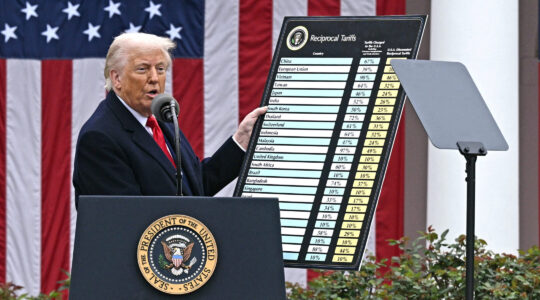NEW YORK (JTA) – In the 19th century, Esther Levy pinpointed a problem: how to juggle being Jewish with being American.
She worried that Jews were assimilating too quickly, shedding their time-honored traditions. So Levy wrote a Jewish cookbook, the first of its kind in this country.
Encyclopedic in scope, “Jewish Cookery Book on Principles of Economy: Adapted for Jewish Housekeepers with the Addition of Many Useful Medicinal Recipes and Other Valuable Information Relative to Housekeeping and Domestic Management,” by Mrs. Esther Levy, was published in 1871 by W.S. Turner of Philadelphia.
While that was a mouthful, the book is now back in print with a trimmer title. In 2004 Dover Publications published an unabridged copy called “The First Jewish-American Cookbook.”
Taking modern readers back to a world ruled by elegance, Levy wrote a remarkable culinary and historical document that offered surprisingly modern and quaintly dated recipes with practical advice on keeping a kosher home, managing a household with finesse and instructing servants.
Like other recipe collections of its time, the book included medicinal recipes and concoctions for cleaning every belonging that could soil or smell.
Levy was a woman of refined taste when it came to entertaining and the presentation of food. She addressed readers with the confidence of Martha Stewart.
“The table should be well polished and covered with a green baize cloth, over which a fine damask one should be spread,” she wrote.
“Plates and dishes must be hot,” she instructed. “Bread should be cut in pieces about an inch thick, or pastry rolls should be used. Lights, either at or after dinner, should be subdued and above guests, if possible, so as to be shed upon the table without intercepting the view.”
Although she left many clues about her world, sadly little is known about Levy. She was born Esther Jacobs, probably in England. Most likely she lived in Philadelphia at a time when synagogues and Jewish newspapers flourished, as did economic opportunities for upwardly mobile Jews.
While her cookbook featured a smattering of recipes for Passover, with recipes such as Matzo Cleis Soup and Matzo Fitters, she didn’t cover Jewish holidays, nor did she mention Thanksgiving.
At the time, no statistics were kept on how many 19th century Jews embraced the American harvest holiday, but much can be learned from Levy’s cookbook about what Jews ate during November.
She was quite specific about autumn entertaining, writing that “Sauces … vegetables and sliced cucumbers, or glazed onions for fall goose, should always be placed on the sideboard.”
The cookbook outlined the foods in season during each month of the year. In November, turkeys and other foul were abundant, as were potatoes, parsnips, turnips, lettuce, cabbage and apples – the foods most Americans eat at Thanksgiving today. The recipes below call for this cornucopia of seasonal produce.
Levy’s cookbook offered two ways to prepare holiday birds:
“To BOIL A TURKEY, stuff it with breadcrumbs and seasonings. Boil the bird in a floured cloth to make it white.”
Repulsive to today’s sensibilities, this method makes amusing reading.
“TO ROAST TURKEY,” Levy recommended a sausage stuffing. “Baste it [the turkey] well and dredge with flour while basting. Serve it up with a nice gravy. Garnish with veal sausage.”
Drawing on typical British, German, French and American fare, her cookbook also is a good source for how to throw a formal dinner. Some of her advice sounds familiar, while other rules seem archaic.
“The first course generally consists of soups and fish, which are removed for the roasts, stews, etc. of the second course,” she wrote.
If two soups are presented, terrines should be set at the head and foot of the table. If four soups are served, then place terrines on all four sides of the table. Even by Jewish standards, offering four soups at one meal exhibits a generous abundance.
The first course is followed by “delicate vegetables dressed in the French style, puddings, creams, jellies, etc.”
Aside from pastry served on elevated stands, fruit was the prevailing dessert.
“The side and corner dishes, usually put on for dessert, consist of compotes in glass dishes,” she wrote, describing many styles of serving fruit – fresh, dried or frosted.
Thanksgiving is an old-fashioned holiday that has evolved over the centuries, so it’s interesting to glance back at how affluent Jews ate and entertained during November in mid-19th century America. As harvest fare is essentially kosher, I suspect Levy would not have discouraged Thanksgiving celebrations, as long they were done in style.
“There should always be a corkscrew ready, and funnel with strainer, and brad-awl to break the wire of the champagne bottles, and the other to strain port wine, if required for dinner,” she wrote.
Naturally she advised polishing stemware until crystal clear.
Levy’s purpose in writing a cookbook was to offer practical advice for New World Jews “without benefit of a traditional ethnic education.” In other words, she was encouraging an American lifestyle while maintaining Jewish values, a delicate balancing act still in progress.
Prim and proper, Levy’s voice continues to resonate today.
I have adapted these recipes drawn from “The First Jewish-American Cookbook” to meet modern tastes and measurement standards. Written in paragraph form, many of her directions lack yields and precise ingredient amounts, skip steps or assume a level of skill that home cooks may lack.
Added as an option, margarine was a rare commodity in America before World War I. It was invented in France in 1870.
In spite of modifications, the essence of Levy’s intentions was honored.
VEGETABLE SOUP
Ingredients:
1/2 head of romaine lettuce
4 tablespoons butter, cooking oil or non-hydrogenated margarine
3 onions, peeled and diced
3 turnips, peeled and diced
1/2 teaspoon chopped dried mint or more if desired
1 teaspoon fresh or dried parsley, chopped
Salt and pepper to taste
2 quarts, plus 1 cup, of water
1 tablespoon flour
2 (10-ounce) packages frozen peas, defrosted
Preparation:
1. Rinse lettuce leaves and shake dry. Stack several leaves and cut them in 1/2-inch widths, creating ribbon-like slices. Continue until all leaves are cut.
2. Briefly heat shortening on a low flame in a large pot. Add lettuce, onions, turnips, mint, parsley, salt and pepper.
3. Cover pot and simmer on the lowest possible flame for 30 minutes. (Add more shortening, if needed.) Then pour 2 quarts of water into the vegetable pot. Check seasoning. Soup will probably need more salt. Cover pot and simmer for 2 hours.
4. Pour 1 cup water into a medium bowl. Sprinkle flour, a little at a time, over water, whisking vigorously after each addition, until flour is fully incorporated and lumps disappear. Reserve.
5. Before using, whisk flour mixture again and add to pot, along with peas. Simmer for 15 minutes. Serve immediately, or cool to room temperature and refrigerate for no more than 3 days before reheating on a low flame. Yield: 8 servings.
KERTOFFLE CHARLOTTE
(A Potato Kugel with Fall Spices)
Ingredients:
6 medium-sized baking potatoes, peeled
No-stick vegetable spray
1/2 cup plain bread crumbs, plus 1/4 cup
1 egg, beaten
Salt to taste
Pepper to taste
4 tablespoons melted butter or margarine, preferably non-hydrogenated
1/2 teaspoon ground ginger
1/2 teaspoon ground nutmeg
Preparation:
1. Grate potatoes by hand or use the grating attachment of a food processor. If you use a food processor, place grated potato shreds in a colander and drain excess liquid by pressing down with the palm of your hand.
2. Preheat oven to 450 degrees. Coat a 9-by-13 inch ovenproof baking pan with no-stick vegetable spray.
3. Move grated potatoes to a large bowl. Add 1/2 cup breadcrumbs and remaining ingredients. With a wooden spoon, gently mix ingredients together, until well incorporated.
4. Spoon potato mixture evenly in prepared pan. Sprinkle 1/4 cup breadcrumbs over the top. Bake 30 to 40 minutes, or until casserole bubbles and top turns crunchy brown. Center will remain soft. Serve immediately. Yield: 6-8 servings.
CABBAGE (with Brisket in a Sweet and Sour Sauce)
Note: This recipe is intended as a side dish.
Ingredients:
2 1/2-pound brisket, fat trimmed
Salt and pepper to taste
2 tablespoons cooking oil
1 beef bouillon cube
1 small red or green cabbage, about 2 1/4 pounds
1/2 teaspoon Allspice
1/2 cup white vinegar
1 tablespoon sugar
Preparation:
1. On top and bottom sides of brisket, sprinkle salt and pepper. Heat oil in a large pot on a medium flame and brown brisket in oil. Add enough water to submerge brisket, about 5-6 cups. Drop bouillon cube into water. Stir occasionally until it melts. Reduce heat so that brisket gently simmers on the lowest flame possible for 30 minutes.
2. Meanwhile, remove outer leaves from cabbage. Rinse and cut into thin slices, discarding the core.
3. To the brisket po t, stir in Allspice, vinegar, and sugar. Add cabbage and stir. Add more salt, if needed. Cover and continue simmering on a low flame for 90 minutes, or until meat feels tender when pierced with a fork.
4. Turn off flame. Remove brisket and slice thin. Cut slices horizontally into halves or thirds, depending on length.
5. If serving immediately, drain sauce from cabbage and pour into a gravy boat. Place cabbage on a platter and top with brisket. Or cool, refrigerate, and serve within 3 days. (Recipe pairs nicely with the Kertoffle Charlotte above.) Yield: 6-8 servings (as a side dish).
SHORT PASTE FOR TARTS (Tart Dough)
Note: European recipes, particularly for baking, often indicated measurements by weight, rather than volume.
Ingredients:
1/2 pound flour (1 1/2 cups)
1 ounce sugar (1/8 cup)
Pinch of salt
1/4 pound butter or non-hydrogenated margarine (1 stick), cut into 8 pieces
1 egg
1 to 2 tablespoons cold water, or less
Preparation:
1. Place flour in the bowl of an electric stand mixer. With a large spoon, make a well in the flour.
2. Place sugar, salt, butter or margarine, and egg in the well. On a low speed, mix ingredients with a dough hook or flat beater attachment. (Whisk attachment is too weak.) Once flour is moistened, increase speed to high. With machine running, add water a few drops at a time until incorporated. Add water carefully until dough clumps and forms a stiff consistency. If you add too much water dough, it will become sticky and unworkable for tarts.
TART ASSEMBLY
(by Linda Morel)
Ingredients:
No-stick vegetable spray
3-4 baking apples, such as Gala, Cortland or Empire
Preparation:
1. Preheat oven to 350 degrees. Coat a 9-inch springform pan with no-stick vegetable spray.
2. Place dough inside pan. With fingers press dough to spread evenly across the bottom of the pan. Press dough up the sides of the pan 1/4 of an inch.
3. Peel and core apples. Slice apples paper thin and arrange in concentric circles, starting at the edge of the pan and moving toward the center. Cover gaps between apple slices by overlapping with additional slices. Apples should cover bottom of pan completely.
4. Bake for 1 hour, or until apples darken, perhaps blackening at edges, and dough turns golden brown. Serve immediately or at room temperature. Yield: 10 slices.
JTA has documented Jewish history in real-time for over a century. Keep our journalism strong by joining us in supporting independent, award-winning reporting.





